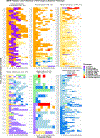Chronic Hepatitis Is Common and Often Untreated Among Children with Hepatitis B Infection in the United States and Canada
- PMID: 34022250
- PMCID: PMC8478804
- DOI: 10.1016/j.jpeds.2021.05.035
Chronic Hepatitis Is Common and Often Untreated Among Children with Hepatitis B Infection in the United States and Canada
Abstract
Objective: To determine the outcomes of chronic hepatitis B virus (HBV) infection in a large, prospectively studied cohort of children in the US and Canada.
Study design: This was a prospective, observational study of children with chronic HBV enrolled in 7 clinical centers and evaluated at baseline, weeks 24 and 48, and annually thereafter, with analysis of demographic, clinical, physical examination, and blood test data.
Results: Among 362 children followed for a median of 4.2 years, elevated alanine aminotransferase (ALT) levels (>1 upper limit of normal) were present in 72% at last evaluation, including in 60% of children with loss of hepatitis B e antigen during follow-up and 70% of those who were hepatitis B e antigen negative at baseline. Significant ALT flares (male patients ≥400 U/L, female patients ≥350 U/L) occurred in 13 children. Of 129 children who fulfilled the American Association for the Study of Liver Diseases treatment criteria during follow-up, anti-HBV treatment was initiated in only 25. One child died (unrelated to liver disease), 1 developed cirrhosis, but no episodes of cirrhotic decompensation or hepatocellular carcinoma were observed. Decline in platelet count was inversely associated with ALT elevations.
Conclusions: In a cohort of children with chronic HBV infection in the US and Canada, many children remained at risk of progressive liver disease due to active hepatitis, but major clinical outcomes such as cirrhosis, cancer, and death were rare. Many children who met criteria for treatment remained untreated.
Keywords: alanine aminotransferase; clinical outcomes; entecavir; interferon; lamivudine; phenotype; platelet count; vertical transmission.
Copyright © 2021 Elsevier Inc. All rights reserved.
Figures










Comment in
-
Hepatitis B in Children-The Pursuit of a Hepatitis Free Future Generation.J Pediatr. 2021 Oct;237:9-11. doi: 10.1016/j.jpeds.2021.07.017. Epub 2021 Jul 14. J Pediatr. 2021. PMID: 34273356 No abstract available.
References
-
- World Health Organization. Global health sector strategy on viral hepatitis, 2016–202: Towards ending viral hepatitis. Geneva: World Health Organization; 2016.
-
- World Health Organization. Global Hepatitis Report, 2017. Geneva: World Health Organization; 2017.
-
- Lok AS, McMahon BJ, Brown RS Jr, Wong JB, Ahmed AT, Farah W, et al.Antiviral therapy for chronic hepatitis B viral infection in adults: A systematic review and meta-analysis. Hepatology. 2016; 63: 284–306. - PubMed
-
- World Health Organization. Global Health Estimates 2016: Deaths by Cause, Age, Sex, by Country and by Region, 2000–2016. Geneva, World Health Organization; 2018.
-
- World Health Organization. Preventing perinatal hepatitis B virus transmission: a guide for introducing and strengthening hepatitis B birth dose vaccination. Geneva; World Health Organization; 2015. http://www.who.int/iris/handle/10665/208278
Publication types
MeSH terms
Substances
Grants and funding
LinkOut - more resources
Full Text Sources
Other Literature Sources
Miscellaneous

